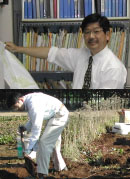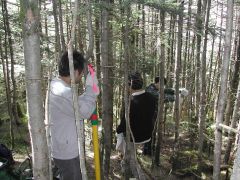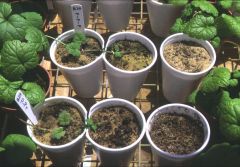|
|
 Plant Ecology Laboratory
Plant Ecology Laboratory
|
We have conducted research to understand ecological events occurring among higher plants using various temporal and spatial scales from diverse aspects. In addition to field studies in Ogasawara and Kita-Yatsugatake, we also focused on experimental studies using a greenhouse, field and climate chamber as well as theoretical research by computer simulation.
|
|
Prof |
Jun-Ichirou Suzuki |
e-mail |
|
|
Ast Prof |
Yuuya Tachiki |
e-mail |
|
|
|
Approach through field surveys
|
|

There are three important approaches to ecological research. One is the field survey, in which the overall goal is to qualitatively and quantitatively clarify what happens on a “site” investigated in order to establish the specificity of the “site” or to discover rules or regularities which are more universally applicable. This approach can be regarded as an inductive research approach. Even if a known role or regularity is verified in the field, the results heavily depend on an inherency of the “site” where the investigation is conducted. In this sense, field surveys focus on diversity rather than commonality between the two aspects characterizing living organisms.
Our laboratory has conducted research based on the uniqueness of an individual “site” using the Hinata-green area in the campus, Ogasawara, the Tamagawa Riverside, Kita-Yatsugatake, Mt. Fuji, and seminatural grasslands in Europe as the “site” of our field surveys. Details of these studies can be found on the website of our laboratory.
|
|
|
Experimental approaches
|
|

Another important approach in ecology research is growth experiments performed in a field, greenhouse or climate chamber. Computer simulations can also be regarded as growth experiments. In a growth experiment, the plants investigated or growth conditions can be selected with some flexibility according to the research goal. Therefore, generality or roles observed in ecological events can be examined in a more direct manner. In this context, the experimental approach is a deductive approach focusing on commonality rather than diversity.
Our laboratory has used fields, greenhouses and climate chambers in the campus and computers as the “site” of the growth experiment to perform our research. Plants used for the growth experiments include thale cress (Arabidopsis thaliana L. Heynh), bird's-foot trefoil (Lotus corniculatus L. var. japonicus Regel), and morning glory (Ipomoea nil), which are model plants widely used in biology research, and Glechoma hederacea L. subsp. grandis, water lettuce (Pistia stratiotes L.), radish (Raphanus sativus var. radicula), and egg plant (Solanum melongena L.).
These two approaches are both essential to study the ecology. For this reason, laboratory members specializing in field surveys and those specializing in growth experiments participate and discuss in the same group. Some researchers also use both approaches for their work. We strongly believe that this research system is the best approach to studying ecology.
|
|
|
Theoretical approaches
|
|
The third approach is constructing theories on the basis of mathematical modelings and computer simulations. We abstract a core of ecological phenomenon and describe it mathematically, which is mathematical modeling. We try to find ecological principles in nature by analyzing the models.
We focus mainly on ecological phenomena for plants and species interaction with plants, but theoretical approach is applicable for any biological domains and kingdoms.
|
|
|
Recent Publications
|
|
- Tsunoda, T., Kachi, N. & Suzuki, J-I. (2017) Effects of the vertical distribution of a root-feeding insect (Anomala cuprea) on the yield, mortality, and size structure of Lolium perenne populations at different plant densities. Botany, 95, 37-44.
- Tsunoda, T., Kachi, N. & Suzuki, J-I. (2017) Belowground herbivory decreases shoot water content and biomass of Lolium perenne seedlings under nutrient-poor conditions. Botany, 95, 29-36.
- Hosaka, N., Kachi, N., Kudoh, H., Stuefer, J.F. & Whigham, D. (2016) Compensatory growth of the clonal understory tree, Asimina triloba, in response to small-scale disturbances. Plant Ecology, 217, 471-480.
- 沼田真也・可知直毅・保坂哲朗(2016)研究活動は観光資源になり得るか?日本の世界自然遺産地における 学術研究活動の役割. 観光科学研究, 9, 119-124.
- Hata, K., Kawakami, K. & Kachi, N. (2016) Increases in soil water content after the mortality of non-native trees in oceanic island forest ecosystems are due to reduced water loss during dry periods. Science of the Total Environment, 545-546, 372-380.
- Osawa, T., Hata, K. & Kachi, N. (2016) Eradication of feral goats enhances expansion of the invasive shrub Leucaena leucocephala L. on Nakoudo-jima, an oceanic island. Weed Research, 56, 168-178.
- Hata, K., Kawakami, K. & Kachi, N. (2015) Higher soil water availability after removal of a dominant, non-native tree (Casuarina equisetifolia Forst.) from a subtropical forest. Pacific Science, 69, 445-460
- Hiradate, S., Morita, S., Hata, K., Osawa, T., Sugai, K. & Kachi, N. (2015) Effects of soil erosion and seabird activities on chemical properties of surface soils on an oceanic island in Ogasawara Islands, Japan. Catena,133, 495-502
- Mizuki, I., Sato, A., Matsuo, A., Suyama, Y., Suzuki, J.-I. & Makita, A. (2014) Clonal structure, seed set, and self-pollination rate in mass-flowering bamboo species during off-year flowering events. PLOS ONE, DOI: 10.1371/journal.pone.0105051
- Matsuo, A., Tomimatus, H., Suzuki, J.-I., Saitoh, T., Shibata, S., Makita, A. & Suyama, Y. (2014) Female and male fitness consequences of clonal growth in a dwarf bamboo population with a high degree of clonal intermingling. Annals of Botany, 114, 1035-1041
- Sakata, T., Nakano, T. & Kachi, N. (2014) Effects of internal conductance and Rubisco on the optimum temperature for leaf photosynthesis of Fallopia japonica growing at different altitudes. Ecological Research, http://link.springer.com/article/10.1007/s11284-014-1223-5
- Tsunoda, T., Kachi, N. & Suzuki, J-I. (2014) Interactive effects of soil nutrient heterogeneity and belowground herbivory on the growth of plants with different root foraging traits. Plant and Soil 384, 347-362
- Tsunoda, T., Kachi, N. & Suzuki, J-I. (2014) Effects of belowground vertical distribution of a herbivore on plant biomass and survival in Lolium perenne. Ecological Research 29, 351-355
- Tsunoda, T., Kachi, N. & Suzuki, J-I. (2014) Effects of belowground herbivory on the survival and biomass of Lolium perenne and Plantago lanceolata plants at various growth stages. Botany 92, 737-741
- Tsunoda, T, Kachi, N. & Suzuki, J-I. (2014) Availability and temporal heterogeneity of water supply affect the vertical distribution and mortality of a belowground herbivore and consequently plant growth. PLOS ONE : DOI: 10.1371/journal.pone.0100437
- Hata, K., Kohri, M., Morita, S., Hiradate, S. & Kachi, N. (2014) Complex interrelationships among aboveground biomass, soil chemical properties, and events caused by feral goats and their eradication in a grassland ecosystem. Ecosystems 17, 1082-1094
- Suzuki, R. O. & Kachi, N. (2014) Effects of local densities and abiotic microenvironments on reproductive outputs of a biennial, Lysimachia mauritiana var. rubida. Plant Species Biology, 29, 217-224.
- Tsunoda, T, Kachi, N. & Suzuki, J.-I. (2014) Availability and temporal heterogeneity of water supply affect the vertical distribution and mortality of a belowground herbivore and consequently plant growth. PLOS ONE, DOI: 10.1371/journal.pone.0100437
- Hata, K., Kohri, M., Morita, S., Hiradate, S. & Kachi, N. (2014) Complex interrelationships among aboveground biomass, soil chemical properties, and events caused by feral goats and their eradication in a grassland ecosystem. Ecosystems, 17, 1082-1094.
- Tsunoda, T., Kachi, N. & Suzuki, J.-I. (2014) Interactive effects of soil nutrient heterogeneity and belowground herbivory on the growth of plants with different root foraging traits. Plant and Soil, 384, 347-362.
- Tsunoda,T., Kachi,N. & Suzuki, J.-I.(2014) Effects of belowground herbivory on the survival and biomass of Lolium perenne and Plantago lanceolata plants at various growth stages. Botany, 92,737-341.
- Tsunoda, T., Kachi, N. & Suzuki, J.-I. (2014) Effects of belowground vertical distribution of a herbivore on plant biomass and survival in Lolium perenne. Ecological Research, 29, 351-355.
- Sakata, T., Nakano, T. & Kachi, N. (2014) Effects of internal conductance and Rubisco on the optimum temperature for leaf photosynthesis of Fallopia japonica growing at different altitudes. Ecological Research, 30, 163-171.
- Mizuki, I., Sato, A., Matsuo, A., Suyama, Y., Suzuki, J.-I., Makita, A. (2014) Clonal structure, seed set, and self-pollination rate in mass-flowering bamboo species during off-year flowering events. PLOS ONE, DOI: 10.1371/journal.pone.0105051
- Matsuo, A., Tomimatus, H., Suzuki, J.-I., Saitoh, T., Shibata, S., Makita, A., Suyama, Y. (2014) Female and male fitness consequences of clonal growth in a dwarf bamboo population with a high degree of clonal intermingling. Annals of Botany, 114, 1035-1041.
- Nishitani, S., Nakamua, T. & Kachi, N. (2013) Nitrogen uptake during the leafless period in juvenile plants of a winte-green perennial herb Lycoris radiata var. radiata (Amaryllidaceae), Botany 91: 715-721
- Takayama, K., Kudoh, H. & Kachi, N. (2013) Loss of seed Buoyancy in Hibiscus glaber on the Oceanic Bonin Islands. Pacific Science 67: 591-597
- Suzuki, S.N., Kachi, N. & Suzuki, J-I. (2013) Spatial variation in local stand structure in an Abies forest, 45 years after a large disturbance by the Isewan typhoon. Journal of Forest Research 18:130-148
- Hagiwara, Y., Kachi, N. & Suzuki, J-I. (2012) Effects of temporal heterogeneity of water supply and nutrient levels on plant biomass growth depend on the plant's relative size within its population. Ecological Research 27: 1079-1086
- Hata, K., Kato, H. & Kachi, N. (2012) Leaf litter of the invasive Casuarina equisetifolia decomposes at the same rate as that of native woody species on oceanic islands but releases more nitrogen. Weed Reseach 52: 542-550
- Suzuki, S.N., Kachi, N. & Suzuki, J-I. (2012) Variability of local spatial structure in a wave-regenerated Abies forest. Ecological Research 27: 893-902
- Shahpasand, K., Uemura, I., Saito, T., Asano, T., Hata, K., Shibata, K., Toyoshima, Y., Hasegawa, M. & Hisanaga, S-I. (2012) Regulation of Mitochondrial Transport and Inter-Microtubule Spacing by Tau Phosphorylation at the Sites Hyperphosphorylated in Alzheimer’s Disease. Journal of Neuroscience 32: 2430-2441
- Suzuki, R.O., Numata, S., Okuda, T., Nur Supardi MD. Noor, Abdul Rahman Kassim & Kachi, N. (2012) Species associations among dipterocarp species co-occurring in a Malaysian tropical rain forest. Journal of Tropical Ecology 28: 281-289
- Hata, K. Kato, H. & Kachi, N. (2012) Seedlings of a native shrub can establish under forests dominated by an alien tree, Casuarina equisetifolia, on subtropical oceanic islands. Journal of Forest Research 17: 208-212
- Hagiwara, Y., Kachi, N. & Suzuki, J-I. (2012) Combined effects between temporal heterogeneity of water supply, nutrient level, and population density on biomass of four broadly distributed herbaceous species. Journal of Plant Research 125: 77-83
- Suzuki, R.O. & Suzuki, S.N. (2012) Morphological adaptation of a palatable plant to long-term grazing can shift interactions with an unpalatable plant from facilitative to competitive. Plant Ecology, 213: 175-183
- Kohri, M., Kamada, M. & Nakagoshi, N. (2011) Spatial-temporal distribution of the ornithochorous seeds from an Elaeagnus umbellata community dominating a riparian habitat. Plant Species Biology 26: 174-185
- Kagaya, M., Tani, T. & Kachi, N. (2011) Maternal and paternal effects on germination time of non-dormant seeds of a monocarpic perennial species, Aster kantoensis (Compositae). Plant Species Biology : 26: 66-77
- Hata, K., Kato, H. & Kachi, N. (2010) Litter of an alien tree, Casuarina equisetifolia, inhibits seed germination and initial growth of a native tree on the Ogasawara Islands, subtropical oceanic islands. Journal of Forest Research 15: 384-390
- Hata, K., Suzuki, J-I., H. & Kachi, N. (2010) Fine-scale spatial distribution of seedling establishment of the invasive plant, Leucaena leucocephala, on an oceanic island after feral goat extermination. Weed Research 50: 472-480
- Hata, K., Kato, H. & Kachi, N. (2010) Litterfall in forests dominated by an alien woody species, Casuarina equisetifolia, on Chichijima Island. Ogasawara Research 35: 1-14
- Kagaya, M., Tani, T. & Kachi, N. (2009) Variation in flowering size and age of a facultative biennial species Aster kantoensis (Compositae) in response to nutrient availability. American Journal of Botany 96: 1808-1813
- Suzuki, S. N., Kachi, N. & Suzuki, J-I. (2009) Changes in variance components of forest structure along a chronosequence in a wave-regenerated forest. Ecological Research 24: 1371-1380
- Hata, K., Kato, H. & Kachi, N. (2009) Community structure of saplings of native woody species under forests dominated by an alien woody species, Casuarina equisetifolia, on Chichijima Island. Ogasawara Research, 34, 33-50
- Suzuki, R. O., Numata,S., Okuda,T., Nur Supardi MD Noor & Kachi, N.(2009) Growth strategies differentiate spatial patterns of 11 dipterocarp species coexisting in a Malaysian tropical rain forest. Journal of Plant Research,122, 81-93.
- Suzuki, S., Kachi, N. & Suzuki, J-I. (2008) Development of a local size-hierarchy causes regular spacing of trees in an even-aged Abies forest: analyses using spatial autocorrelation and the mark correlation function. Annals of Botany,102, 435-441
- Nakamura, R., Kachi, N. & Suzuki, J-I. (2008) Plant growth and root growth of Lolium perenne before reaching a nutrient-rich patch in a heterogeneous soil. Journal of Plant Research,121, 547-557
- Kagaya, M., Tani, T. & Kachi, N. (2008) Effect of gravel conditions on seedling emergence of an endangered monocarpic perennial, Aster kantoensis (Compositae), on a floodplain. Plant Species Biology 23: 47-50
- Hosaka, N., Kachi, N., Kudoh, H., Steufer, J. F.,& Whigham, D. F. (2008) Patch structures and ramet demography of the clonal tree, Asimina triloba, under gap and closed-canopy. Plant Ecology : in press
- Shimamura, R., Kachi, N., Kudoh, H. & Whigham, D. F. (2007) Hydrochory as a determinant of genetic distribution of seeds within Hibiscus moscheutos (Malvaceae) populations. American Journal of Botany 94: 1137-1145
- Mishio, M., Kawakubo, N. & Kachi, N. (2007) Intra-specific variation of leaf morphology and photosynthetic traits in Boninia grisea Planchon (Rutaceae) endemic to the Bonin Islands, Japan. Plant Species Biology 22: 117-124
- Sakata, T., Kachi, N. & Yokoi, Y. (2007) Quantitative evaluatioinn of the couterbalance between photosynthetic stimulation and depreession caused by partial ppreessure of O2 and CO2 in alpine atmospheres. Polar Science 1: 55-62
- Hata, K., Suzuki, J-I. & Kachi, N. (2007) Effects of an alien shrub species, Leucaena leucocephala, on establishment of native mid-successional tree species after disturbance in the national park in the Chichijima island, a subtropical oceanic island. Tropics 16: 283-290
|
|
|